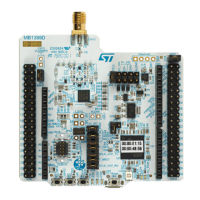Peripherals interconnect matrix RM0453
448/1461 RM0453 Rev 1
12.3.2 From timer (LPTIM1/LPTIM2) to timer (LPTIM3)
Purpose
Some timers are linked together internally for synchronization or chaining.
When one timer is configured in Master mode, it can reset, start, stop or clock the counter of
another timer configured in Slave mode. A description of the feature is provided in
Section 25.3.26: Timer synchronization.
Triggering signals
The output is on signals LPTIMx_OUT following a configurable timer event. The input (to
slave) is on signals LPTIM3_ETR.
The input and output signals for LPTIM are shown in Figure 261: Low-power timer block
diagram.
The possible connections are given inTable 194: LPTIM3 external trigger connection.
Active power modes
Run, Sleep, LPRun, LPSleep, Stop 0, Stop 1
12.3.3 From timer (TIM1/TIM2) and GPIO pin EXTI to ADC/DAC
Purpose
Advanced-control timer TIM1, general-purpose timer TIM2 and GPIO pin EXTI can be used
to generate an ADC/DAC trigger event.
TIMx synchronization is described in Section 25.3.27: ADC synchronization.
GPIO pin EXTI mux is described in Section 11: System configuration controller (SYSCFG).
ADC synchronization is described in Section 18.4: Conversion on external trigger and
trigger polarity (EXTSEL, EXTEN).
DAC synchronization is described in Section 19.4.7: DAC trigger selection.
Triggering signals
The output from timer is on signals TIMx_TRGO, TIMx_TRGO2, TIMx_CCx, TIMx_CHn
event. The output from GPIO pin is on EXTI mux signal from SYSCFG.
The input to ADC is on signals TRG[7:0].
The connection between timers, GPIO pin EXTI mux and ADC, is provided inTable 102:
External triggers.
The input to DAC is on signals dac_ch1_trg[15:0].
The connection between timers, GPIO pin EXTI mux and DAC, is provided inTable 114:
DAC interconnection.
Active power modes
Run, Sleep, LPRun, LPSleep

